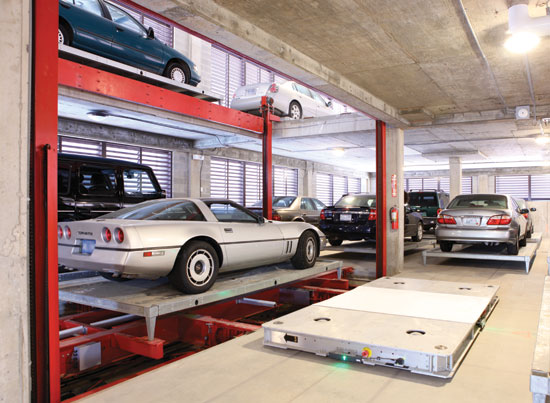Robots Update the Parking Garage
Learning Objectives:
- Explain the forces driving the adoption and subsequent evolution of automated parking systems (APS).
- Discern between the various types of mechanical and automated parking systems.
- Identify concerns that drove the evolution of automated parking systems.
- Discuss the application of Automated Guided Vehicle (AGV) technology to improving parking solutions.
- Identify the economic benefits of using an automated parking system.
- Summarize how automated parking systems can expand design possibilities and contribute to LEED® points.
Credits:
According to the 2010 Census, 81 percent of the U.S. population now live in urban areas, and that number is steadily on the rise. Similarly, the United Nations report “State of World Population 2007” projected that the world's urban population is expected to rise from 3.3 to almost 5 billion by 2030. Despite efforts to increase the utilization of mass transit, many urban dwellers still want to own an automobile. The swelling urban population and desire to own an automobile have combined to make the provision of adequate parking supply a major problem for developers and planners.
The most popular solution for increasing parking density to date has been the construction of ramp-access self-park garages. Despite the fact that some experts feel the parking garage “defines how people live and what industrialized society has become,”1 the economic and structural realities of building ramp-access garages have historically relegated them into a “blind spot” within urban design. The major reason being that in order for ramp-access garages to be cost effective, they require construction methods that make them unattractive and difficult to conceal. When faced with the task of designing a ramp-access parking structure, many architects have taken great pains to make their garages attractive, but this is not easy to do.
It appears this may need to change soon. Since it is so difficult to integrate enough shops and restaurants into highly efficient parking structures, their use creates “dead zones” in the city. Devoid of natural foot traffic, these massive ramp-access parking structures often fall into disrepair, becoming magnets for crime. Many municipal governments have realized how disruptive ramp-access garages are to the urban fabric of our cities, and are looking for ways to mitigate their negative impact.
Mechanical vs. Automated Parking Systems
Automated parking systems represent a practical and affordable solution to increase parking density since they use up to 50 percent less volume to park the same number of cars as a typical ramp-access self-park garage. As a result, more architects are becoming aware of new developments in parking technology and the significant benefits they offer.
 |
Robots store and retrieve cars on steel trays in this latest-generation automated parking system in Crystal Springs Resort, Hardyston, New Jersey. Photo courtesy of Boomerang Systems, Inc. |









